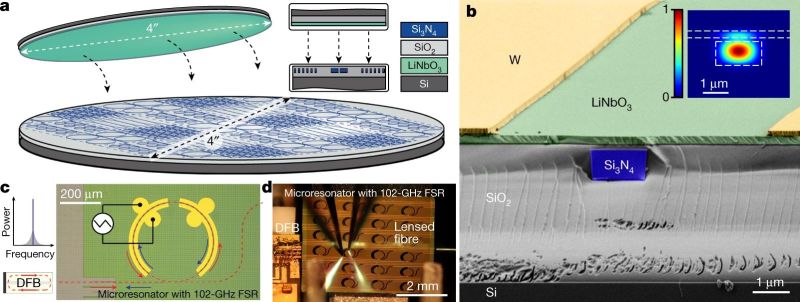Making lasers smaller and more capable of rapidly alternating between frequencies, while remaining within a narrow band, is an essential part of bringing down the cost of technologies such as LiDAR and optical communication. Much of the challenge here lies understandably in finding the right materials that enable a laser which incorporates all of these properties.

Here a recent study by [Viacheslav Snigirev] and colleagues (press release) demonstrates how combining the properties of lithium niobate (LiNbO3) with those of silicon nitride (Si3N4) into a hybrid (Si3N4)–LiNbO3 wafer stack allows for an InP-based laser source to be modulated in the etched photonic circuitry to achieve the desired output properties.
Much of the modulation stability is achieved through laser self-injection locking via the microresonator structures on the hybrid chip. These provide optical back reflection that forces the laser diode to resonate at a specific frequency, providing the frequency lock. What enables the fast frequency tuning is that this is determined by the applied voltage on the microresonator structure via the formed electrodes.
With a LiDAR demonstration in the paper that uses one of these hybrid circuits it is demonstrated that the direct wafer bonding approach works well, and a number of optimization suggestions are provided. As with all of these studies, they build upon years of previous research as problems are found and solutions suggested and tested. It would seem that thin-film LiNbO3 structures are now finding some very useful applications in photonics.
(Heading image: Stack of Si3N4-LiNbO3 forming the integrated laser and integrated into test setup (d). (Credit: Snigirev et al., 2023) )

















As part of my apprenticeship rotation 47 years ago, I found myself in the materials lab at Glasgow University Electronics department.
I was tasked with manually measuring and plotting the piezoelectric characteristics of a glassy material over a range of voltages and frequencies.
I remember thinking ‘What’s the point of all this? What possible use could it ever be?’
Yes, that 1976 ‘glass’ was lithium niobate and now it’s being used to tune lasers in 2023.
It tells me that some new tech has been decades in the building, and some of that building is done by surly teenagers.
:-)
That’s VERY cool. Not only were you working on some new technology that seemingly had no good purpose, BUT, you have lived to see an application of that technology, although some decades later.
ALL!!! technology is ultimately based on basic research.
That’s why the question “OK, but does this have any practical application?” is meaningless.
It is funny “Standing on the shoulders of giants” has become “standing on the shoulders of a massive pyramid of people stretching back back centuries”
Billions and billions of years. That’s a lot of grant money.
I don’t think that anything had shoulders to stand on until some time after the first vertebrates appeared 600 million years ago, so not actually billions and billions.
We stood on .
Everything creative is a remix of a past event.
I was there 28 years ago. Who did you work for?
Many decades ago in my apprenticeship days, I used to grow rubies for the MoD. The components were heated in an induction crucible and a small “seed” dipped in a pulled out producing a long ruby. I could never get an answer as to what these rubies were used for. Turns out that they were used in building lasers.
As has been said before, some tech has been decades in the building, and some of that building was done by surly teenagers.
So if we pass that laser beam through prism, does that mean we can have solid state system that steers direction of that beam?
In the 90s, we used variable frequency diode lasers for a measurement system. The lasersʻ center frequency was set by adjusting current and temp of the diode. The frequency sweep was through a tunable resonator on the die. Not sure if the lasers ever became a commercial product but we had a few of the first batch. This method could be more viable.
Many old (and likely also new) DWDM lasers get tuned that way. Gota hit thoer 100GHz and 50GHz ITU channels, and stay on the channel.
@synthimuse
While I can totally sympathize with your feeling of meeting an old acquaintance, it seems that lithium niobate already had its place as a Very Interesting Material Indeed [1] for a while. Reminds me of doing Wikipedia Rabbit Holing more often (pick an element of the periodic table and follow some random path aong its chemical compounds)
[1] https://en.wikipedia.org/wiki/Lithium_niobate